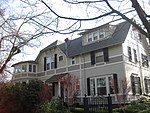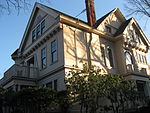Jacob Kamm House
1871 establishments in OregonGoose Hollow, Portland, OregonHouses completed in 1871Houses on the National Register of Historic Places in Portland, OregonPortland Historic Landmarks

The Jacob Kamm House, also called the Jacob Kamm Mansion, is a French Second Empire style mansion in Portland, Oregon, built in 1871. It was moved from its original location on SW 14th and Main to its current location in Goose Hollow in 1950 to make room for Lincoln High School's campus. It was purchased by preservationist Eric Ladd for $1,000 at auction and moved to its present location, along with two other houses Ladd was interested in preserving, at SW 20th and Jefferson, which was called "the colony."
Excerpt from the Wikipedia article Jacob Kamm House (License: CC BY-SA 3.0, Authors, Images).Jacob Kamm House
Southwest 20th Avenue, Portland Goose Hollow
Geographical coordinates (GPS) Address External links Nearby Places Show on map
Geographical coordinates (GPS)
| Latitude | Longitude |
|---|---|
| N 45.517646 ° | E -122.695029 ° |
Address
Kamm House
Southwest 20th Avenue 1425
97201 Portland, Goose Hollow
Oregon, United States
Open on Google Maps









